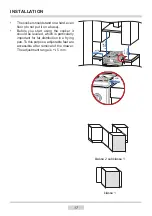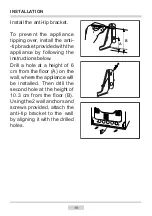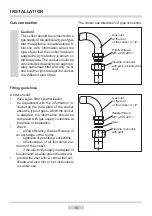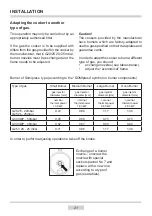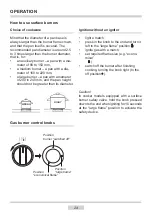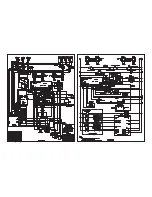
16
INSTALLATION
The following instructions are addressed to
the qualified specialist installing the cooker.
These instructions aim at ensuring that
installation and maintenance activities are
performed as professionally as possible.
•
Prior to installation, ensure that the local
distribution conditions (nature of the gas
and gas pressure) and the adjustment of
the appliance are compatible.
•
The adjustment conditions are stated on
the label (or data plate).
•
This appliance is not connected to a
combustion products evacuation device.
It shall be installed and connected in ac-
cordance with current installation regula-
tion. Particular attention shall be given
to the relevant requirements regarding
ventilation.
Installing the cooker
•
The kitchen should be dry and airy and
have effective ventilation according to
the existing technical provisions.
•
The room should be equipped with
a ventilation system that pipes away
exhaust fumes created during combus
-
tion. This system should consist of a
ventilation grid or hood. Hoods should
be installed according to the manufac
-
turer’s instructions. The cooker should
be placed so as to ensure free access
to all control elements.
•
The room should also enable the neces
-
sary air supply for proper gas combus
-
tion. Air supply should be not less than
2m
3
/h per 1 kW of burner heat. The air
can be delivered from outside by a duct
with a section of at least 100cm
2
, or
indirectly from adjoining rooms which
are fitted with ventilation ducts leading
outside.
•
If the appliance is used intensively and
for a long time, it may be necessary
to open a window in order to improve
ventilation.
•
In terms of protection against the over
-
heating of surrounding surfaces, the
gas cooker is an X – class appliance
and can be built into furniture only up
to the level of the cooking hob, that is
around 850 mm above the floor. Rais
-
ing furniture construction over this level
is inadvisable. Coating or veneer used
on fitted furniture must be applied with
a heat resistant adhesive (100°C). This
prevents surface deformation or detach
-
ment of the coating. If you are unsure
of your furniture’s heat resistance, you
should leave approximately 2 cm of
free space around the cooker. The wall
behind the cooker should be resistant to
high temperatures. During operation, its
back side can warm up to around 50°C
above the ambient temperature.
















